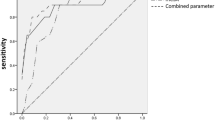Abstract
We aimed to evaluate the importance of neck/thyromental distance in the diagnosis of moderate to severe obstructive sleep apnea (OSA) in sleep clinics. 185 patients (122 males, 63 females) referred to our sleep clinic with OSA symptoms were enrolled to the study. The patients had level-1 polysomnography (PSG). The neck circumference (N), thyromental distance (T), and STOP test were recorded in all patients. Using an obstructive AHI > 15 event/h on PSG as the cut-off, the best N/T ratio to find patients with OSA was calculated with the receiver operator curve analyses. The best cut-off for N/T was chosen as 4.6. We used Modified STOP test: STO-NT test in which P (for hypertension item) was replaced with N/T ratio. N/T ratio >4.6 was scored as “positive”. Two positives out of four questions in STO-NT were scored as high risk for OSA. The OSA prevalence was 60 % for AHI > 15. The mean ratio of N/T was significantly different between groups with AHI > 15 and AHI ≤ 15. N and N/T ratio were moderately correlated with AHI. Sensitivity, specificity, negative predictive value, positive predictive value, and negative likelihood ratio of STOP test for AHI > 15 were 88.5, 28.4, 61.8, 65.4 % and 0.40, whereas 97.3, 23, 85, 65.9 % and 0.12 for STO-NT test, respectively. STO-NT test seems better than STOP test in determining patients who do not likely to have moderate to severe OSA in sleep clinics so can be preferred to decide on therapies other than CPAP in a short time.




Similar content being viewed by others
References
Victor LD (1999) Obstructive sleep apnea. Am Fam Physician 60(8):2279–2286
Netzer NC, Stoohs RA, Netzer CM, Clark K, Strohl KP (1999) Using the Berlin Questionnaire to identify patients at risk for the sleep apnea syndrome. Ann Intern Med 131(7):485–491
Sharma SK, Vasudev C, Sinha S, Banga A, Pandey RM, Handa KK (2006) Validation of the modified Berlin questionnaire to identify patients at risk for the obstructive sleep apnoea syndrome. Indian J Med Res 124(3):281–290
Chung F, Yegneswaran B, Liao P, Chung SA, Vairavanathan S, Islam S, Khajehdehi A, Shapiro CM (2008) STOP questionnaire: a tool to screen patients for obstructive sleep apnea. Anesthesiology 108(5):812–821. doi:10.1097/ALN.0b013e31816d83e4
Ong TH, Raudha S, Fook-Chong S, Lew N, Hsu AA (2010) Simplifying STOP-BANG: use of a simple questionnaire to screen for OSA in an Asian population. Sleep Breath 14(4):371–376
Chai-Coetzer CL, Antic NA, Rowland LS, Catcheside PG, Esterman A, Reed RL, Wiliams H, Dunn S, McEvoy RD (2011) A simplified model of screening questionnaire and home monitoring for obstructive sleep apnoea in primary care. Thorax 66(3):213–219
Shahid A, Wilkinson K, Marcu S, Shapiro CM (2012) STOP, THAT and One Hundred other Sleep Scales. Springer, Berlin
Izci B, Ardıç S, Fırat H, Şahin A, Altınörs M, Karacan I (2008) Reliability and validity of studies of the Turkish version of the Epworth Sleepiness Scale. Sleep Breath 12:161–168
Chung F, Subramanyam R, Liao P, Sasaki E, Shapiro C, Sun Y (2012) Hight STOP-Bang cores indicates a high probability for obstructive sleep apnoea. Br J Anaesth 108(5):768–775. doi:10.1093/bja/aes022
Center for Disease Control (CDC) (2012) Vital signs: awareness and treatment of uncontrolled hypertension among adults—United States, 2003–2010. Morb Mortal Wkly Rep 61:703–709
Onat A, Hergenc G, Yüksel H, Can G, Ayhan E, Kaya Z, Dursunoglu D (2009) Neck circumference as a measure of central obesity: associations with metabolic syndrome and obstructive sleep apnea syndrome beyond waist circumference. Clin Nutr 28:46–51. doi:10.1016/j.clnu.2008.10.006
Subramanian S, Jayaraman G, Majid H, Aquilar R, Surani S (2012) Influence of gender and anthropometric measures on severity of obstructive sleep apnea. Sleep Breath 16(4):1091–1095. doi:10.1007/s11325-011-0607-9
Pinto JA, Godoy LB, Marquis VW, Sonego TB, Leal Cde F, Artico MS (2011) Anthropometric data as predictors of obstructive sleep apnea severity. Braz J Otorhinolaryngol 77(4):516–521
Lam B, Ip MS, Tench E, Ryan CF (2005) Craniofacial profile in Asian and white subjects with obstructive sleep apnoea. Thorax 60(6):504–510
Friedman M, Tanyeri H, La Rosa M, Lansberg R, Vaidyanathan K, Pieri S, Calderelli D (1999) Clinical predictors of obstructive sleep apnea. Laryngoscope 109:1901–1907
Scheeellenberg JB, Moislin G, Schwab RJ (2000) Physical findings and the risk of obstructive sleep apnea. Am J Respir Crit Care Med 162:740–748
Kim WH, Ahn HJ, Lee CJ, Shin BS, Ko JS, Choi SJ, Ryu SA (2011) Neck circumference to thyromental distance ratio: a new predictor of difficult intubation in obese patients. Br J Anaest 106(5):743–748
Lewis M, Keramati S, Benumof JL, Berry CC (1994) What is the best way to determine oropharyngeal classification and mandibular space length to predict difficult laryngoscopy? Anaesthesiology 81:69–75
American Academy of Sleep Medicine (2005) International classification of sleep disorders: diagnostic and coding manual, 2nd edn. American Academy of Sleep Medicine, Westchester
Mc Gee S (2002) Simplifying likelihood ratios. J Gen Intern Med 17:647–650
Ferguson KA, Takashu D, Ono T, Lowe AA, Ryan CF, Fleetham JF (1995) The relationship between obesity and craniofacial structure in obstructive sleep apnea. Chest 108:375–381
Schellenberg JB, Maislin G, Schwab RJ (2000) Physical findings and the risk of obstructive sleep apnea. Am J Respir Crit Care Med 162:740–748
Hiremath AS, Hillman DR, James AL, Noffsinger WJ, Platt PR, Singer SL (1998) Relationship between difficult tracheal entubation and obstructive sleep apnea. Br J Anaesth 80:606–611
Krobbuaban B, Diregpoke S, Kumkeaw S, Tanomsat M (2005) The predictive value of the height ratio and thyromental distance: four predictive tests for difficult laryngoscopy. Anaesth Analg 101:1542–1545
Conflict of interest
We have no conflicting interests in this study.
Author information
Authors and Affiliations
Corresponding author
Rights and permissions
About this article
Cite this article
Yuceege, M., Firat, H., Altintas, N. et al. The utility of neck/thyromental ratio in defining low-risk patients with obstructive sleep apnea in sleep clinics. Eur Arch Otorhinolaryngol 271, 2575–2581 (2014). https://doi.org/10.1007/s00405-014-3062-y
Received:
Accepted:
Published:
Issue Date:
DOI: https://doi.org/10.1007/s00405-014-3062-y




